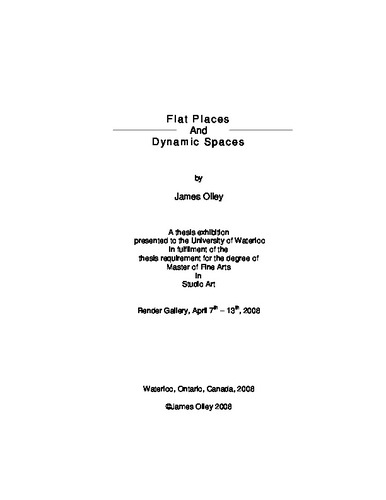Flat Places and Dynamic Spaces
| dc.contributor.author | Olley, James | |
| dc.date.accessioned | 2008-05-06 16:19:21 (GMT) | |
| dc.date.available | 2008-05-06 16:19:21 (GMT) | |
| dc.date.issued | 2008-05-06T16:19:21Z | |
| dc.date.submitted | 2008-05-01 | |
| dc.identifier.uri | http://hdl.handle.net/10012/3636 | |
| dc.description.abstract | As found in modern art and architecture during the 1950’s and 1960’s, North Americans were conditioned through advertising and media to adopt modernism as a new and better way of life. Modernist styles such as Abstract Expressionism were promoted as leading edge ways to make art that defined American culture. In architecture, modernism infiltrated the development of suburbs and represented a way of life that promoted consumerism, leisure and the nuclear family. Much of the urban and suburban spaces we live in have been influenced by modernism. I am interested in exploring the vocabulary of modernist abstraction through the language of contemporary figuration. I am influenced by late modernist Formalism, colour field painting, gestural mark making and Abstract Expressionism. | en |
| dc.language.iso | en | en |
| dc.publisher | University of Waterloo | en |
| dc.subject | Urban Painting | en |
| dc.subject | modern architecture | en |
| dc.subject | modernism | en |
| dc.subject | suburban | en |
| dc.subject | Painting | en |
| dc.subject | late modernist Formalism | en |
| dc.title | Flat Places and Dynamic Spaces | en |
| dc.type | Master Thesis | en |
| dc.pending | false | en |
| dc.subject.program | Studio Art | en |
| uws-etd.degree.department | Fine Arts | en |
| uws-etd.degree | Master of Fine Arts | en |
| uws.typeOfResource | Text | en |
| uws.peerReviewStatus | Unreviewed | en |
| uws.scholarLevel | Graduate | en |

